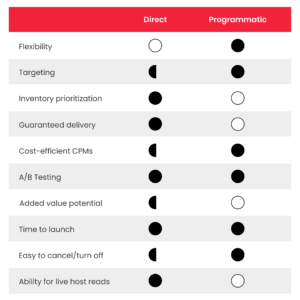
In 2024, podcast advertising is on track to continue its tremendous growth. The combination of accessible platforms, captive audiences, and niche markets provides advertisers with unique opportunities to connect with target audiences. The podcast advertising market is expected to maintain a steady annual growth rate of 7.76% in the next several years, reaching $5.03 billion by 2027. Given this momentum, many brands are considering how to maximize ROI, which inevitably leads to questions about buying.
Open exchange programmatic and direct buying are the two primary ways that brands can purchase podcast ad space. While each method has its advantages, understanding the key differences can help buyers make informed decisions and craft a comprehensive media strategy to meet their goals. At ARM, we know both programmatic and direct buying are critical components in a successful audio campaign and we guide our clients with intention to the right mix of both. Keep reading for an overview of how direct and programmatic buying via exchanges work and the benefits of each method.

What’s the difference between programmatic and direct buying?
Programmatic advertising includes any ad that is transacted or fulfilled via automation. While this can occur within the confines of a specific publisher’s inventory such as through a private marketplace (PMP), it typically refers to inventory accessed via an open exchange or demand-side platform (DSP), which aggregates inventory from across media companies.
With programmatic advertising, marketers plug in campaign information, targeting criteria, and campaign goals, and then the campaign is executed automatically. The model uses real-time bidding, machine learning, and artificial intelligence.
Direct buying involves people working directly with media companies to handle ad placement. Marketing team members reach out to ad space vendors, express interest in placing ads, identify optimal ad inventory, and handle negotiations.
Targeting, reporting, and guaranteed delivery
Programmatic podcast advertising leverages large amounts of online data based on specified parameters to identify and reach desired audiences. It offers a variety of targeting options; demographics such as behaviors and interests can be targeted, for example, regardless of the context of the page audience members are visiting.
Despite these advantages, buying podcast ads through a DSP can create more work for buyers. Marketing teams must vet hosts and podcast content to identify effective, brand safe partnerships or use technology to ensure brand suitability. At ARM, we leverage tech like Sounder and Barometer to guarantee that every programmatic placement is delivered in an appropriate environment that matches brand values. Precise measurement, reporting, and evaluation become increasingly important with programmatic to ensure targeting yields maximum results.
When buying directly from a podcast network, the network uses the parameters provided by the marketing team to set up the campaign, allowing for precise ad placement and making niche placement all the more refined. Typically, the number of impressions is guaranteed, which can ensure the volume of impressions booked matches what is delivered.
While transacting through a DSP can often deliver better reporting, including which touchpoints users interact with before clicking on programmatically placed ads, direct sold offers equal benefits that include trust, one-to-one advising, and optimal placement and pricing.
Ad placement and launch times
With programmatic advertising, campaigns are often faster to launch, and while they run, the platform will continually analyze and optimize performance. This promotes accuracy and efficiency but gives the marketer no direct control over ad placement. Additionally, programmatic is easier to turn off in response to changes in market conditions, budget, or promotion schedule. Programmatic has the added benefit of allowing brands to automate campaigns based on specific criteria such as snowy weather, depending on the product, service, and creative. With programmatic buys, however, brands also have less visibility into which shows they are buying or the percentage of inventory available for specific show titles.
At times, optimizations are required to ensure that programmatic campaigns run efficiently and teams gain more control over targeting parameters and segments, requiring additional involvement from marketing teams. At ARM, we pride ourselves on innovating in the audio industry. To address the need for a human touch in programmatic campaigns, we have developed ARM PRO: Audience, an audience-buying engine that lets brands pinpoint their target market across a human-vetted, brand-suitable suite of audience environments.
Since buying directly involves human experts overseeing the configuring and trafficking of your ads, it is easier to have precise control over where they run. Teams can ensure that their campaigns align with specific demographics, interests, and geographic locations with ease. This method is dependent on the buyer’s expertise and contacts to work optimally. While advertisers have more control over ad placements with direct buying, pricing and timeline negotiations can result in longer campaign launch times, but often involve less testing to maximize campaign results.
Inventory and pricing
When it comes to pricing, programmatic generally is less expensive than direct buying, making it a great option for clients with smaller budgets. Programmatic buying takes place in real-time auctions where advertisers bid for ad placements. This pricing strategy means that clients pay based on market demand, with higher bids winning auctions for ad inventory.. Since buyers can target a specific audience segment across networks with DSPs, it is also a great way for clients new to audio to test with smaller spend.
Direct buying can be more expensive than programmatic and often requires a minimum budget. Layers of expert oversight for identifying optimal ad spaces, contacting vendors, and handling negotiations can create additional cost, though direct buying often produces superior creative and offers brands an opportunity to reap the benefits of industry guidance so ad dollars are not wasted.
Another difference is that certain inventory isn’t currently available to buy programmatically. Typically, content sponsorships, host-read integrated ads, and custom formats are bought directly from platforms like Spotify, Pandora, or iHeartMedia. Buying direct results in less ad clutter with lower ad load on a show-by-show basis, improving the chances of an ad being heard.
Pricing models also differ between programmatic and direct buying. Bid prices vary on programmatic platforms based on user conversions. High conversion rates mean an increase in CPM pricing. When buying direct, marketers typically pay a flat fee and receive a guarantee that a certain number of impressions will be reached.
How to choose the right mix
Ad spend on programmatic in general increased from $117 million in 2022 to $238 million in 2024—an increase of over 100%. Yet, according to Digiday, “host-read ads are still king in the medium.”
Both programmatic and direct buying are proven, effective podcast buying methods, but with known differences in execution and benefits. Brands should explore the capabilities of each and plan their media mix around short- and long-term campaign objectives and goals, matching the specifics of each method to the results they aim to achieve.
After decades in the audio game, ARM has observed that a combination of programmatic and direct buying produces the most profound ROI for our clients. It’s our goal to offer guidance to our partners from the start to finish of every campaign—ensuring that they invest wisely in the space, uncover the right partnerships, and eliminate wasted dollars. Our goal is to identify the right mix for your goals—now and in the future.
Balance your podcast portfolio by getting in touch with an audio strategist from ARM today. Let’s talk.


